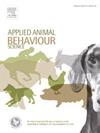Environment change causes a transient adverse impact on horse behavioral resting patterns
IF 2.2
2区 农林科学
Q1 AGRICULTURE, DAIRY & ANIMAL SCIENCE
引用次数: 0
Abstract
The influence of the environment on resting patterns in horses is not completely understood. We aimed to investigate if the behavioral resting patterns of sports horses change from their home environment to a hospital environment because we hypothesized that moving to a hospital environment might negatively impact the horses' resting patterns. Eight Quarter horses were recorded for three days in their home environment to determine the baseline resting pattern, for five days at the Teaching Hospital of the University, and for a further three days following their return to their home environment. The latency for each horse performance the first sternal and lateral recumbency was computed and compared between the hospital and home environment post-hospitalization. The frequency and duration of sternal and lateral recumbency were lower on the days of hospitalization compared with the baseline (p < 0.05). The frequency and duration of sternal and lateral recumbency were returned to baseline values on the first night of their return to their home environment. The latency for the first sternal and lateral recumbency was higher in the hospital environment than in the home environment post-hospitalization. These behavioral resting pattern changes might be understood as transitory because it returned to the baseline pattern on the first night when horses returned to their home environment. In conclusion, the horses investigated in this initial study decreased their resting behaviors when hospitalized for five days. Future studies are necessary to enlarge the sampling size and quantify the impact of this resting behavior reduction on the horses’ quality of life.
求助全文
约1分钟内获得全文
求助全文
来源期刊

Applied Animal Behaviour Science
农林科学-行为科学
CiteScore
4.40
自引率
21.70%
发文量
191
审稿时长
18.1 weeks
期刊介绍:
This journal publishes relevant information on the behaviour of domesticated and utilized animals.
Topics covered include:
-Behaviour of farm, zoo and laboratory animals in relation to animal management and welfare
-Behaviour of companion animals in relation to behavioural problems, for example, in relation to the training of dogs for different purposes, in relation to behavioural problems
-Studies of the behaviour of wild animals when these studies are relevant from an applied perspective, for example in relation to wildlife management, pest management or nature conservation
-Methodological studies within relevant fields
The principal subjects are farm, companion and laboratory animals, including, of course, poultry. The journal also deals with the following animal subjects:
-Those involved in any farming system, e.g. deer, rabbits and fur-bearing animals
-Those in ANY form of confinement, e.g. zoos, safari parks and other forms of display
-Feral animals, and any animal species which impinge on farming operations, e.g. as causes of loss or damage
-Species used for hunting, recreation etc. may also be considered as acceptable subjects in some instances
-Laboratory animals, if the material relates to their behavioural requirements
 求助内容:
求助内容: 应助结果提醒方式:
应助结果提醒方式:


